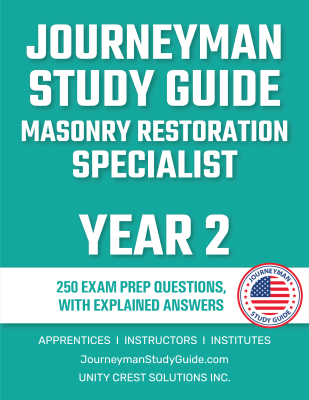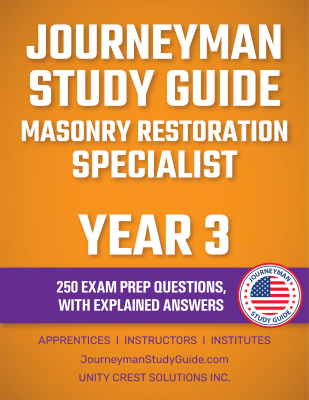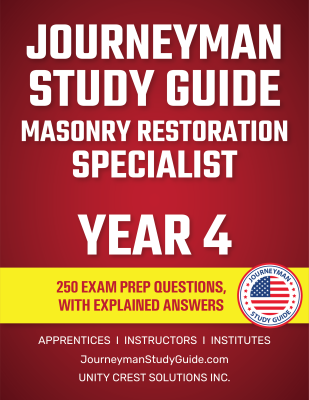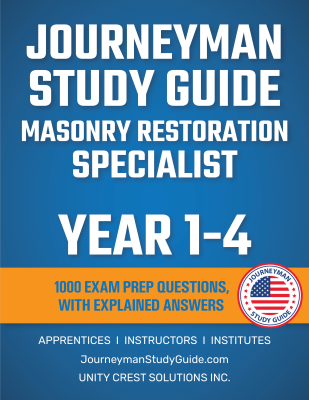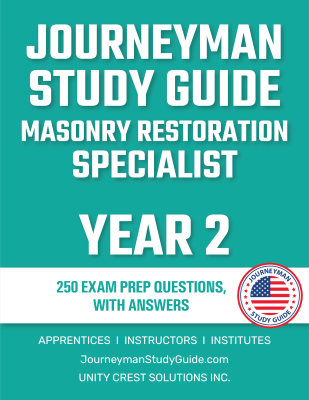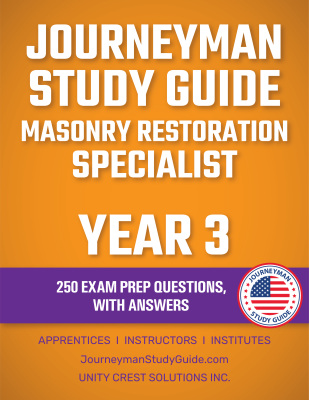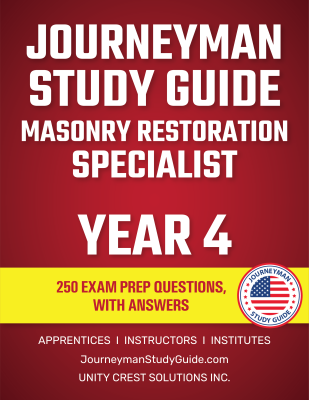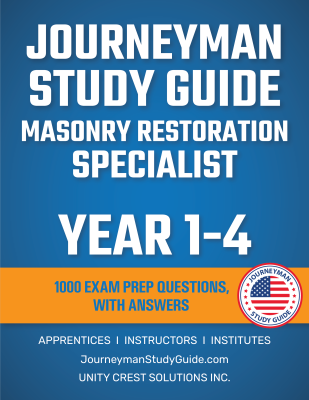Questions, Answers, & Explanations
Get clear explanations behind every answer, perfect for deeper learning and more thorough exam preparation.
Site Updates in Progress: Things might look different as we work on enhancing your experience.
What Is Masonry Restoration?
Masonry restoration is a specialized trade focused on the repair, preservation, and rehabilitation of brick, stone, terra cotta, and concrete structures. Unlike new masonry construction, restoration work involves diagnosing deterioration, matching historical materials, and applying precise repair techniques that honor the original architecture. This trade is essential in maintaining America’s heritage—particularly in cities with aging infrastructure like New York, Boston, Philadelphia, and Chicago.
Key Responsibilities
As a Masonry Restoration Specialist, your work goes far beyond laying bricks. You are expected to analyze and restore complex architectural details with precision and care. Day-to-day duties may include:
You may work on historic courthouses, academic institutions, museums, churches, and even national landmarks under the guidelines of local and federal preservation codes.
Skills and Traits for Success
Masonry restoration requires a combination of hands-on skill and historical knowledge. The most successful tradespeople in this field demonstrate:
• Attention to Detail
Matching centuries-old materials and maintaining architectural integrity demands sharp visual perception and precision.
• Historical Sensitivity
Understanding the significance of preserving original features is crucial when restoring heritage buildings.
• Technical Proficiency
Knowledge of traditional mortars, lime-based products, and specialty coatings like breathable sealants is a must.
• Physical Endurance
The work is physically demanding, involving lifting, climbing, and working in all weather conditions.
• Problem-Solving Skills
Each building presents unique challenges—whether it’s structural instability or sourcing rare replacement materials.
Where Masonry Restoration Specialists Work
This trade is in high demand in older American cities where historic buildings make up a significant portion of the urban landscape. Restoration specialists can be found working for:
Training & Certification
Many specialists begin as bricklayer apprentices and then pursue advanced restoration skills. Programs in historic masonry are offered at:
Additional certifications, such as OSHA 30-Hour Construction Safety, Scaffold User Training, and Silica Dust Control are essential for safety and employability.
Why Choose This Career?
Masonry restoration is more than a job—it’s a legacy. Skilled professionals in this trade enjoy:
• Strong Job Demand
With many buildings over 75 years old across the U.S., demand for qualified restoration specialists is growing—especially in historic districts and coastal regions.
• Competitive Wages
Union members and certified specialists often command higher pay due to the expertise required for this meticulous work.
• Pride in Purpose
Restore buildings that define America’s cultural and architectural identity.
• Career Advancement
Skilled restorers often become foremen, consultants, or even launch their own restoration firms.
Get Ready for Your Career in Masonry Restoration!
Sharpen your skills and master restoration techniques with our Q&A guides, Q&A with Explanations, and Online Tests—everything you need to succeed in this essential trade.
What to Expect on the Masonry Restoration Certification Exam
The Masonry Restoration Specialist certification exam is designed to assess your technical knowledge, safety practices, and hands-on skills in the field of historic and structural masonry repair. While there is no single national certification, exams are typically offered through trade unions, industry organizations, and local licensing boards in states like New York, Illinois, and California. Many employers—particularly union shops and historic preservation contractors—require proof of competency through testing.
Passing the exam shows that you’re qualified to restore brick, stone, and concrete structures with historical accuracy and modern performance standards.
Exam Format
While exact details may vary by region or training program, most certification exams follow a similar structure:
Some training providers, such as the International Masonry Training and Education Foundation (IMTEF), require hands-on modules to be completed before the written portion of the test is administered.
Topics Covered on the Exam
The Masonry Restoration Specialist exam typically covers five core areas:
1. Masonry Materials and Tools
Understand the differences between clay brick, limestone, granite, sandstone, terra cotta, and concrete block. You’ll also be tested on proper use of trowels, jointers, grinders, chisels, and pointing tools.
2. Mortar Composition and Application
Identify the types of mortar (Type N, S, O, and historic lime-based blends), their appropriate uses, and how to match color, texture, and tooling profiles to original installations.
3. Deterioration and Repair Methods
Recognize signs of damage such as spalling, efflorescence, and cracking. Learn methods like tuckpointing, patching, replacing failed units, and stabilizing structures.
4. Safety and Jobsite Protocols
Questions will cover scaffold safety, silica dust exposure prevention (OSHA standards), PPE use, and working in occupied or historic environments.
5. Blueprint Reading and Historical Sensitivity
You’ll need to read basic architectural drawings and understand guidelines for restoring heritage sites in accordance with standards set by the Secretary of the Interior’s Standards for the Treatment of Historic Properties.
Passing Requirements
Most masonry restoration exams require a minimum passing score of 70%. However, some hands-on demonstrations are scored on a pass/fail basis and must be completed to standard.
In union settings—such as through BAC Local 1 NY, BAC Local 3 California, or BAC Local 4 Indiana/Kentucky—certification may also involve employer feedback, instructor evaluation, and time-in-trade requirements.
How to Prepare for the Exam
Success on the Masonry Restoration certification exam depends on both study and hands-on experience. Here’s how to get ready:
• Use Study Guides and Practice Questions
Our Q&A guides and Q&A with Explanations focus on the exact material you'll face on the exam. These tools break down complex topics and provide real-world examples from U.S. job sites and projects.
• Take Online Practice Tests
Our interactive Online Tests simulate the real exam experience, complete with timing and immediate scoring. This helps you build confidence and identify knowledge gaps.
• Enroll in a Training Program
Consider a union-sponsored apprenticeship through Bricklayers & Allied Craftworkers or formal education through programs like:
• Get Hands-On Practice
Work under the supervision of a journeyman on live restoration projects. Experience is critical in developing your eye for material matching, mortar tooling, and jobsite efficiency.
• Stay Current on Safety Standards
Review OSHA regulations, especially those related to scaffold use, silica dust, and historic structure preservation. Most exams will include scenario-based questions on workplace safety.
Master the Masonry Restoration Exam Today
Maximize your success with our complete preparation suite: Q&A Guides, Q&A with Explanations, and Online Tests—designed to help you pass your exam and launch a rewarding career in masonry restoration.
What Types of Questions Are on the Certification Exam?
The Masonry Restoration Specialist exam includes a mix of multiple-choice, scenario-based, and hands-on questions that reflect real-world jobsite challenges. Whether you’re applying for union certification through Bricklayers & Allied Craftworkers (BAC) or completing an assessment through an employer or technical program, the exam is designed to test your knowledge of materials, repair methods, safety protocols, and historical sensitivity.
Common Question Formats
1. Multiple-Choice Questions
These test your understanding of materials, tools, mortar types, deterioration patterns, and general best practices.
2. Scenario-Based Questions
You may be given a practical problem—for example, how to match a 100-year-old brick profile or correct improperly installed flashing—and asked to choose the best solution based on industry standards.
3. Hands-On Evaluation
In union settings, like those through IMI Training Centers in states like Illinois or New Jersey, you may be required to demonstrate techniques such as tuckpointing, stone patching, or anchoring procedures as part of your exam.
4. Blueprint and Plan Reading
Some questions will test your ability to interpret basic elevation drawings or architectural symbols commonly used in preservation projects.
5. Safety Protocols and Compliance
Expect questions about OSHA guidelines, personal protective equipment (PPE), scaffold use, and best practices for working in historic or occupied buildings.
Sample Questions
Here are a few representative questions to help you understand what to expect:
1. Mortar Matching
What type of mortar should be used when repointing 19th-century lime-based masonry walls?
2. Masonry Deterioration
What is the most likely cause of spalling in historic brick masonry?
3. Tool Identification
Which tool is most commonly used to strike a concave mortar joint?
4. Safety Protocol
According to OSHA regulations, when is fall protection required on a masonry restoration site?
Tips for Answering Exam Questions
To improve your performance on the certification exam, use the following strategies:
• Read Questions Carefully
Misreading terms like "lime-based" versus "Portland cement" can lead to incorrect answers. Take your time and highlight key words in scenario-based questions.
• Use Process of Elimination
Remove clearly incorrect choices to improve your odds. For example, if a question is about restoration and one option involves demolition, you can rule it out quickly.
• Time Management
Most exams allow 2–3 hours. Practice completing questions at a steady pace. Our Online Tests mirror real testing environments to help you track your timing.
• Practice with Tools and Terms
If you're unfamiliar with tools like rakers, margin trowels, or grinders, spend time on job sites or use our Q&A with Explanations to become familiar with their use and purpose.
Practice Questions for Better Preparation
We offer a complete line of study resources designed for American workers:
All materials are aligned with the standards of U.S.-based training institutions like the American College of the Building Arts (South Carolina) and apprenticeship programs through BAC Locals in states such as Pennsylvania, Michigan, and California.
Start Your Exam Prep Today
Master the certification exam with our full suite of tools. Whether you're a new apprentice or an experienced craftsperson pursuing certification, our Q&A guides, explanations, and online tests are designed to help you succeed.
Morning: Planning and Site Setup
The day for a masonry restoration specialist often starts early—especially when working in large cities like Boston, Philadelphia, or Chicago where historic preservation projects are in high demand. The morning begins by reviewing the day’s tasks, safety protocols, and site conditions.
• Reviewing Job Assignments
Workers meet with site supervisors to go over the scope of work, such as repointing a century-old brownstone or repairing terra cotta ornamentation on a civic building.
• Setting Up Tools and Materials
Essential tools like pointing trowels, jointers, grinders, and dust collection systems are laid out. Materials such as Type O mortar, lime putty, or matching salvaged bricks are checked for availability.
• Site Safety and Access
Restoration specialists ensure scaffold systems meet OSHA standards and wear required PPE including hard hats, gloves, eye protection, and sometimes respirators, depending on dust levels and material use. In union environments like those affiliated with Bricklayers & Allied Craftworkers (BAC), safety briefings are a daily routine.
Midday: Restoration Work in Action
Once everything is in place, the bulk of the day is spent restoring, repairing, or rebuilding masonry surfaces. This often involves surgical-level care, especially on historic structures governed by local preservation codes or projects funded through organizations like the National Trust for Historic Preservation.
• Repointing and Repairing
Much of the work involves grinding out failing mortar joints and repointing them with historically accurate mixtures. This requires matching the original joint profile and mortar color to avoid visual inconsistencies. Precision and patience are key.
• Brick and Stone Replacement
When bricks or stones are too damaged to repair, specialists carefully remove and replace them using matching materials—often sourced from U.S. suppliers like Interstate Brick (Utah) or The Belden Brick Company (Ohio).
• Structural Reinforcement
Restorers may also work with engineers to install helical ties, anchors, or flashing systems to preserve structural integrity without altering a building’s appearance.
Afternoon: Detailing and Inspection
The final part of the workday often involves finishing details, site clean-up, and ensuring that the restored sections blend seamlessly with the original masonry.
• Cleaning and Sealing
Specialists use low-pressure washing systems or non-acidic cleaners to remove debris without damaging original surfaces. Some projects may require applying breathable sealants approved for historic materials.
• Quality Control
Before wrapping up, lead restorers perform a close visual inspection. Any misaligned joint, color inconsistency, or tool mark can compromise the authenticity of the restoration.
• Documentation and Client Updates
For government or institutional projects—such as university buildings at Columbia University, Yale, or Stanford—documentation is essential. Restorers take photos, log completed tasks, and provide daily reports to architects or preservation consultants.
Typical Work Environments
Masonry restoration specialists can be found working in a wide range of environments:
Challenges and Rewards
• Common Challenges
• Why It’s Rewarding
Ready to Start Your Journey?
Explore our expert-crafted tools to help you prepare for a successful masonry restoration career. From Q&A guides and detailed answer explanations to online tests, we help you gain confidence before stepping onto the jobsite or into your certification exam.
Earning Potential
A career in masonry restoration offers steady income and room for financial growth. Compensation depends on experience, location, certifications, and union membership.
• Entry-Level Restoration Workers
Newcomers just entering the trade—often through apprenticeships with unions like the International Union of Bricklayers and Allied Craftworkers (BAC)—can expect to earn $40,000 to $50,000 annually, with incremental raises as they gain experience.
• Mid-Level Masonry Technicians
With 5–10 years of experience and specialized skills in tuckpointing, stone repair, or historic preservation, technicians can earn between $55,000 and $75,000 annually, especially in restoration hotspots like New York, Boston, and Washington, D.C.
• Senior Craftsmen and Site Supervisors
Seasoned professionals who lead crews or manage multi-phase preservation projects can earn $80,000 to $100,000+ annually. Those working for restoration firms such as EverGreene Architectural Arts (NY) or Mark 1 Restoration (PA) often oversee major projects with high-profile clients.
Regional Salary Differences
Earnings can vary widely based on location and demand for historic preservation:
Career Growth Opportunities
There are multiple pathways for advancement within the masonry restoration field:
• Apprenticeship to Journeyman
Most professionals begin as apprentices under programs certified by the Department of Labor or run by organizations like the BAC Local 1. After several years, they advance to journeyman status, where they can perform a full range of restoration tasks.
• Lead Restoration Specialist
With enough on-the-job experience, workers can become lead technicians or forepersons responsible for project execution, team oversight, and quality control.
• Project Manager or Estimator
Skilled specialists may transition into management roles, handling logistics, material procurement, and client communication for companies like Jablonski Building Conservation (NYC) or Pullman SST (nationwide).
• Preservation Consultant or Contractor
Experienced professionals may branch out as consultants or start their own businesses. They provide expertise for landmarks, historic districts, and government-funded restoration efforts.
The Benefits of Certification
While masonry is a hands-on trade, certification adds credibility and opens doors to higher pay and more advanced roles.
• National Trust for Historic Preservation
Professionals who work on federally funded sites benefit from training aligned with the Secretary of the Interior’s Standards for Historic Preservation.
• IMI Certifications
The International Masonry Institute (IMI) offers advanced coursework in historic masonry techniques, material science, and sustainable restoration—often in partnership with schools like the College of DuPage (IL) and Savannah Technical College (GA).
• OSHA and Scaffold Certifications
Safety credentials like OSHA 30 or Competent Person Scaffold Training are often required for supervisory roles on restoration sites.
Success Stories
• Marcus – From Apprentice to Supervisor
Marcus started in a BAC Local 3 apprenticeship program in Oakland, CA. Over a decade, he rose to become a restoration crew leader working on landmarks like the San Francisco Ferry Building and now trains new apprentices across the state.
• Elena – Art Conservator Turned Mason
With a degree in art conservation from the University of Delaware, Elena transitioned into masonry restoration and now leads façade projects in New York City. She blends historical research with field expertise to preserve buildings for future generations.
Advance Your Career in Masonry Restoration Today!
From union apprenticeships to advanced certifications, our study materials help you level up your skills and prepare for exams with confidence. Whether you're looking for Q&A study tools, detailed answer explanations, or realistic online tests—we’ve got you covered.
General Wage Ranges
Wages for masonry restoration specialists depend on experience, location, industry, and job responsibilities. The field offers competitive salaries across various roles:
• Entry-Level Restoration Workers
Newcomers to masonry restoration, including those starting through union apprenticeships, can expect to earn between $40,000 and $50,000 annually. This is common for workers in entry-level roles who assist with basic restoration tasks and learning the trade under skilled craftsmen.
• Mid-Career Professionals
With several years of experience and the completion of advanced training, restoration specialists can see their salaries rise to $55,000 to $75,000 annually. Mid-career professionals often take on more complex projects, including stone restoration, masonry preservation, and historic building repairs.
• Senior Specialists & Project Managers
Veterans in the trade with significant expertise in high-profile restoration projects can command $80,000 to $100,000+ annually. Senior professionals may manage large-scale projects, work on landmark buildings, or oversee entire teams of restoration workers.
Regional Salary Differences
Salaries can vary widely based on the location of the work and the specific industries in demand.
Factors That Impact Wages
Several factors influence salaries in masonry restoration. These include educational background, union membership, location, and specialty:
1. Certifications & Education
Advanced certifications, such as those offered by the National Park Service or programs from schools like Georgia State University’s Historic Preservation Program, can increase job prospects and earning potential. Technicians with formal training in masonry preservation techniques often command higher wages.
2. Union Membership
Union membership plays a key role in ensuring fair wages and benefits. Workers who are part of the International Union of Bricklayers and Allied Craftworkers (BAC) or Laborers' International Union of North America (LIUNA) often enjoy better wages, healthcare benefits, and job stability. Union members can see wage increases of 10-15% over their non-union counterparts.
3. Specialized Skills
Restoration specialists with expertise in rare or complex masonry materials such as terra cotta, limestone, or marble, or those skilled in historic preservation techniques, can earn significantly more. Specialized skills are in demand for landmark restoration projects, especially for high-profile clients like the Smithsonian Institution or the National Trust for Historic Preservation.
4. Experience & Project Scope
More experienced specialists working on large-scale, government-funded projects or those involved in the preservation of nationally recognized buildings often earn higher wages due to the complexity and significance of their work.
Earnings by Industry
Masonry restoration is a critical component of several industries, each offering varying wage ranges based on specialization:
Opportunities for Wage Growth
There are multiple ways to increase earning potential in masonry restoration:
1. Advanced Certifications
Pursuing certifications from organizations like the National Preservation Institute (NPI) or specialized courses in historic masonry restoration can boost wages and open doors to higher-level positions.
2. Specialized Training
Learning techniques for stone consolidation, seismic retrofitting, and historic mortar repair can make a technician more valuable in the industry and increase earnings.
3. Union & Employer Partnerships
Working with unions like IAM (International Association of Machinists) or UAW (United Auto Workers) can provide significant wage boosts and benefits, along with job stability.
4. Freelance & Business Opportunities
Many experienced masonry professionals start their own contracting or consulting businesses, which can lead to a higher income and the ability to select larger, more profitable projects.
Maximize Your Earning Potential in Masonry Restoration
Whether you're entering the field or looking to advance your career, our study guides, Q&A explanations, and online tests will help you build the skills needed to succeed. Take control of your career and achieve the certification and expertise to earn top wages in the masonry restoration industry.
Essential Tools for Technicians
In masonry restoration, technicians rely on a wide range of tools to complete precise, high-quality work. Here’s a breakdown of the most commonly used tools in the field:
• Masonry Restoration Tools
Restoration specialists require a combination of traditional tools and modern equipment for brick and stonework. Key tools include:
• Power Tools
Power tools are often necessary to improve efficiency and precision in restoration work:
• Safety Equipment
Safety is paramount in masonry restoration. Ensure you're equipped with:
• Measuring & Alignment Tools
Accuracy in masonry restoration is crucial. To verify precision, technicians use:
Recommended Learning Resources
To excel in the masonry restoration field, there are various resources available to enhance your skills and knowledge. The following institutions and platforms provide essential training in restoration techniques:
• The Masonry Society (TMS)
TMS offers resources and certification programs designed to promote the education and training of masonry professionals across the United States.
• National Trust for Historic Preservation
The National Trust’s training programs and webinars are a fantastic resource for those interested in historic preservation. They offer specialized education on restoring and maintaining heritage buildings, a key aspect of masonry restoration.
• The International Union of Bricklayers and Allied Craftworkers (BAC)
BAC is a union that provides extensive training programs for masonry workers, including apprenticeships and continuing education.
• Building Conservation Associates, Inc.
They cover topics like historic brick repair, stonework conservation, and masonry waterproofing, which are essential skills in the field.
Suppliers and Material Resources
When it comes to sourcing high-quality materials and tools for masonry restoration, these companies are trusted leaders in the U.S. market:
• The Home Depot
Offers a wide range of masonry tools, mortars, and sealants essential for restoration work.
• Grainger
Supplies specialized equipment like diamond blades, anchors, and safety gear for industrial masonry projects.
• Quikrete
Known for durable pre-mixed mortar, cement, and grout, ideal for projects of all sizes.
• Ohio Grout Company
Provides top-quality, non-shrink and acid-resistant grout for specialized restoration needs.
Tips for Building Your Toolkit on a Budget
Starting out in masonry restoration can be costly, but there are ways to build a functional toolkit without breaking the bank. Consider these strategies:
• Start with the Basics
Invest in essential hand tools like trowels, chisels, and measuring tapes before adding power tools. These tools are critical for small-scale repair projects and can help you gain experience.
• Buy Refurbished Equipment
Look for refurbished equipment from trusted brands like Makita or DeWalt. These tools are often certified to work like new and come at a fraction of the price of brand-new items.
• Utilize Open-Source Software
Many masonry restoration technicians now use software for planning and documenting projects. SketchUp is a free, open-source design tool that can be used to create accurate models of restoration work before starting. This helps avoid costly mistakes and ensures a smoother workflow.
• Join a Union for Discounts
Union members often receive discounts on tools and materials through union partnerships. By joining the International Union of Bricklayers and Allied Craftworkers, you could access exclusive deals on supplies and equipment.
Why the Right Tools Matter
Using the right tools not only ensures the quality of the work but also increases efficiency, reduces labor costs, and ensures safety on the job. As a masonry restoration technician, investing in high-quality tools and equipment is an investment in your career. Industry-standard tools help you perform precise and professional restoration work, which will lead to a strong reputation and opportunities for career growth in the field.
Start Building Your Career in Masonry Restoration Today
For a deep dive into the industry and further preparation for certification, check out our Q&A guides, Online Tests, and Q/A Explanations. Enhance your skills and achieve success in the field of masonry restoration.
Where to Learn Masonry Restoration
In the U.S., various institutions offer specialized training programs focused on masonry restoration. Whether you're looking to enter the workforce quickly or pursue advanced education, there are numerous options to help you advance your career in masonry restoration.
• National Masonry Training Institute (NMTI)
NMTI offers hands-on training and certification programs for masonry professionals, including those focused on restoration. Their courses cover essential techniques for working with brick, stone, and concrete in historic restoration projects.
• The International Union of Bricklayers and Allied Craftworkers (BAC)
The BAC provides a variety of apprenticeships and training opportunities. Their programs offer in-depth knowledge of masonry restoration and preservation techniques, as well as comprehensive safety training. With a focus on hands-on experience, BAC ensures that workers are well-prepared to tackle even the most complex restoration projects.
• College of Charleston
Located in Charleston, South Carolina, the College of Charleston offers a program in historic preservation that includes masonry restoration. Their curriculum focuses on the restoration of historic structures, providing students with the knowledge and skills needed for working on heritage buildings.
• University of Pennsylvania – Historic Preservation Program
The University of Pennsylvania offers a Master’s degree in historic preservation, with courses on masonry repair, stone conservation, and brick restoration. This program equips students with both theoretical knowledge and practical skills for working on masonry restoration projects.
Types of Education Programs
The field of masonry restoration offers a variety of educational paths, depending on the student's goals and interests. Here's a breakdown of the most common types of programs:
• Certificate Programs
These short-term programs are designed for those seeking quick, focused training in specific areas of masonry restoration. Certificate programs can be found at institutions like the National Masonry Training Institute and Georgia Masonry Contractors Association. These programs are ideal for individuals looking to upskill or gain specialized knowledge in a short amount of time.
• Associate Degrees
Community colleges across the country, such as Central Piedmont Community College in North Carolina, offer associate degrees in construction management with a focus on masonry restoration. These programs typically include both classroom learning and hands-on training in masonry techniques, as well as safety and project management skills.
• Bachelor’s Degrees
For those looking for a deeper understanding of architecture and restoration, a bachelor’s degree in historic preservation or construction management may be a good choice. University of Vermont offers a Bachelor of Science in Historic Preservation, which includes courses on masonry restoration and preservation methods for historical structures.
• Workshops and Continuing Education
Industry workshops are also available for professionals who want to improve their skills in masonry restoration. Organizations like The National Trust for Historic Preservation and Preservation Trades Network (PTN) offer specialized workshops on historic masonry restoration and stone conservation.
What to Expect in a Training Program
Masonry restoration training programs provide students with a combination of theoretical education and hands-on experience. Here are the key areas students can expect to focus on:
• Masonry Techniques and Practices
Students will learn various masonry techniques, including mortar mixing, brick laying, and stone cutting. Specialized courses also cover techniques for repairing and restoring damaged masonry and preserving historical buildings.
• Material Science and Preservation Methods
Understanding the properties of different masonry materials—such as stone, brick, and mortar—is crucial for restoration. Training programs will include lessons on the importance of material selection and matching historical materials for repairs.
• Safety and Regulations
Masonry restoration requires a strong understanding of safety procedures, especially when working on older, sometimes fragile structures. Programs will cover OSHA regulations, fall protection, scaffolding, and proper handling of materials.
• Historic Preservation Practices
Many restoration projects involve working with historical buildings. Students will gain knowledge in the best practices for maintaining and restoring historical and cultural structures, ensuring that renovations are both aesthetically and historically accurate.
How to Choose the Right Program
When selecting a training program, it's essential to consider several key factors to ensure you’re receiving the best education for your career goals:
• Accreditation
Look for programs accredited by reputable organizations like the National Trust for Historic Preservation or those associated with the International Union of Bricklayers and Allied Craftworkers (BAC). Accreditation ensures that the program meets industry standards and provides quality training.
• Hands-On Training
Choose programs that offer significant hands-on experience with real-world masonry projects. Institutions that partner with historic buildings or provide access to restoration projects allow students to apply what they’ve learned in a practical setting.
• Industry Connections and Job Placement Support
Programs with strong ties to the masonry and construction industries can help students secure employment after graduation. Look for institutions that offer job placement assistance or have partnerships with masonry contractors.
• Specialization in Historic Restoration
If you’re interested in working on historic or cultural buildings, consider programs that offer specialized training in historic masonry techniques. Schools like the University of Pennsylvania and College of Charleston provide advanced education in masonry restoration for historical buildings.
Featured Institutions
Here are some of the top U.S. institutions offering masonry restoration education:
• National Masonry Training Institute (NMTI)
• University of Pennsylvania – Historic Preservation Program
• College of Charleston
• Central Piedmont Community College
Ready to Start Your Masonry Restoration Career?
Whether you're beginning your journey or looking to advance your skills, our Q&A guides, Online Tests, and Q/A Explanations will help you prepare for certification and thrive in the masonry restoration industry.
Why Join a Union or Connect with Employers?
Unions and reputable employers offer significant advantages for masonry restoration professionals. By joining a union or connecting with established employers, workers can gain job security, competitive wages, and opportunities for career growth. In addition, these organizations often provide access to advanced training and specialized workshops, making it easier for individuals to stay updated on the latest industry trends and techniques.
Benefits of Joining a Union
Unions play a crucial role in securing better wages, job security, and enhanced benefits for workers. For masonry restoration specialists, union membership can make a significant difference in long-term career success.
• Higher Wages & Benefits
Union members earn more and enjoy health, retirement, and leave benefits, ensuring financial security.
• Job Security
Unions offer stable work and protection against unfair practices, even during downturns.
• Advanced Training
Members access exclusive training on new masonry techniques, boosting job market value.
• Career Advocacy
Unions fight for fair pay, safety, and workplace rights, giving workers a strong collective voice.
Top Unions for Masonry Restoration Technicians
Several unions in the U.S. represent workers in the masonry restoration industry. These unions offer extensive training opportunities, job placement assistance, and career support.
• International Union of Bricklayers and Allied Craftworkers (BAC)
Main union for masonry pros, offering apprenticeships, training, and job placement.
• Laborers’ International Union of North America (LIUNA)
Covers masonry and restoration workers, providing specialized training and certifications.
• United Brotherhood of Carpenters and Joiners of America (UBC)
Offers apprenticeships and advanced training in masonry restoration and preservation.
• International Association of Iron Workers (IAIW)
Trains workers in stone and brick restoration, especially for industrial projects.
Connecting with Employers
Finding a reputable employer is crucial for advancing your career in masonry restoration. Many employers in the industry offer excellent career opportunities and a chance to work on high-profile restoration projects. Here are some leading companies in the field:
• Restoration & Preservation Services (RPS)
RPS is a leading company in the field of masonry restoration, specializing in the restoration of historic and cultural buildings. They offer job opportunities for skilled masonry restoration specialists and provide on-the-job training in advanced restoration techniques.
• Whelan Restoration
Whelan Restoration is a top player in the masonry restoration field, working on projects ranging from historical buildings to modern structures. The company provides extensive training to its employees and focuses on maintaining the highest standards of craftsmanship and safety.
• Pinnacle Preservation Group
Pinnacle Preservation Group specializes in the restoration of historic properties across the U.S. Their projects include the restoration of landmark buildings and public monuments, offering excellent career opportunities for masonry restoration specialists interested in historical preservation.
• Barton Malow
Barton Malow is a construction company that handles a wide range of projects, including masonry restoration. With a reputation for quality work and a commitment to employee development, they offer competitive pay and benefits for skilled workers in the masonry restoration field.
• Suffolk Construction
Suffolk Construction provides masonry restoration services as part of its broader construction offerings. The company specializes in large-scale projects and historic restorations, making it an ideal employer for those looking to advance in the industry.
Tips for Finding Work
Securing a job in masonry restoration requires more than just technical skills—it also involves effective networking and leveraging industry resources. Here are some tips to help you find employment:
• Network Through Industry Events
Attending conferences and trade shows such as the Preservation Trades Network Annual Conference and National Preservation Conference is a great way to meet potential employers. These events allow you to connect with other professionals and learn about new job opportunities in the masonry restoration field.
• Earn Recognized Certifications
Employers often prioritize candidates who have earned certifications from respected organizations such as the National Trust for Historic Preservation or International Union of Bricklayers and Allied Craftworkers (BAC). These credentials validate your skills and make you more attractive to potential employers.
• Leverage Union Membership
Many unions offer job placement assistance and apprenticeship programs that connect members with employers. By joining a union, you gain access to a network of professionals and potential job opportunities in the masonry restoration field.
Ready to Launch Your Career in Masonry Restoration?
By joining a union and connecting with top employers in the field, you can unlock a wealth of opportunities for career advancement and skill development. To help you prepare for your next job, explore our Q&A guides, Online Tests, and Q/A Explanations. Start preparing today and take your career to the next level!
How to Stay Ahead in the Industry
Masonry restoration is a dynamic field that continues to grow, driven by advancements in technology and techniques. Professionals in this industry need to embrace ongoing learning, attend industry events, and keep up with emerging trends to remain competitive.
Emerging Trends in Masonry Restoration
The masonry restoration industry has seen several key developments in recent years. These trends highlight the importance of staying informed and adapting to changes in the market.
• Advanced Technologies
3D scanning and robotic tools improve precision and efficiency in restoring historic structures, as seen with companies like RPS.
• Sustainability
Eco-friendly materials like recycled bricks and green mortars are gaining popularity, with firms like Whelan Restoration leading the way.
• Historical Preservation
Rising demand for skilled workers to restore landmark buildings creates new job opportunities, supported by groups like the National Trust for Historic Preservation.
• AI Integration
AI tools help with project planning and management, boosting efficiency and offering tech-savvy workers a career edge.
Best Practices for Professional Growth
For masonry restoration professionals looking to grow their careers, following best practices can ensure continued success in the field.
• Continuing Education
Advanced certifications (e.g., AIC) help specialists sharpen skills and stay current on new techniques.
• Networking & Events
Attending conferences like PTN and the National Preservation Conference builds connections and opens career doors.
• Professional Portfolio
A strong portfolio with project photos, case studies, and certifications showcases expertise and attracts employers.
• Adapting to Market Needs
Specializing in areas like historic or sustainable restoration keeps professionals competitive and in demand.
Challenges and Opportunities
Like any industry, masonry restoration presents both challenges and opportunities. Being aware of these can help professionals navigate the field successfully.
Challenges
Opportunities
Sustainability in Practice
The shift towards sustainability in the masonry restoration field is being driven by new eco-friendly practices and materials. Adopting these sustainable practices not only benefits the environment but also meets the growing demand for green construction solutions.
• Eco-Friendly Materials
The use of recycled materials, such as reclaimed bricks and sustainable mortar, is becoming standard in many restoration projects. Companies like Restoration & Preservation Services are leading the charge in using green materials while maintaining the integrity of historical structures.
• Energy-Efficient Restoration
Energy-efficient practices in masonry restoration, such as insulating historical buildings or using low-impact construction methods, are in high demand. By adopting these techniques, restoration specialists can help reduce the energy footprint of old buildings while preserving their historical value.
• Waste Reduction
The restoration industry is increasingly adopting closed-loop recycling systems to reduce waste. These systems allow companies to reuse materials from older structures, minimizing environmental impact and making restoration projects more cost-effective.
Why Staying Ahead Matters
As the masonry restoration field continues to evolve, professionals who adapt to new technologies, certifications, and sustainable practices will secure the best opportunities. The future of this industry looks promising, and staying informed and proactive will ensure that masonry restoration specialists remain competitive in the job market.
Stay Competitive in Masonry Restoration!
Enhance your skills and industry knowledge with our Q&A guides, Q/A Explanations, and Online Tests designed to help you succeed.
Get clear explanations behind every answer, perfect for deeper learning and more thorough exam preparation.
Quick and easy practice to test your knowledge anytime, anywhere—ideal for simple, on-the-go preparation.


